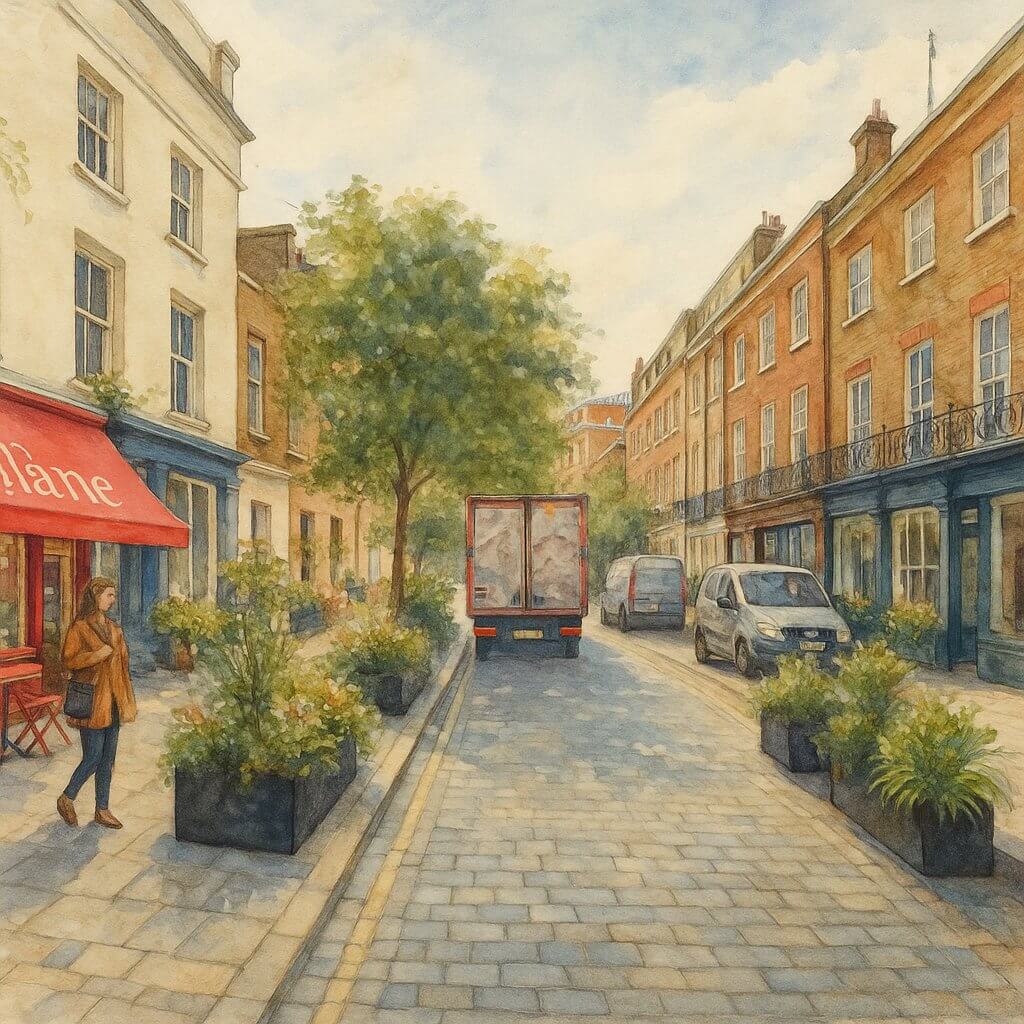
Elizabeth Street, London
Elizabeth Street is a picturesque and prestigious street located in the heart of Belgravia, within the City of Westminster. It runs from Lyall Street near Eaton Square in the west to Elizabeth Bridge in the east, where it meets Pimlico Road and Buckingham Palace Road. Known for its chic boutiques, independent cafés, and seasonal decorations, Elizabeth Street is a favourite destination for both locals and discerning visitors.
Location and Layout
Elizabeth Street lies in one of the most exclusive corners of central London. It serves as a key spine of the Belgravia neighbourhood, connecting the refined residential atmosphere of Eaton Square to the more commercial areas around Victoria.
The street stretches approximately 600 metres (about 0.37 miles) in length. It is open to two-way traffic for most of its length, though the eastern end near Elizabeth Bridge becomes more restricted, especially for large vehicles. Pavements are broad and well-kept, supporting the street’s reputation as a pedestrian-friendly shopping destination.
Streets branching from Elizabeth Street
- Buckingham Palace Road
- Chester Row
- Chester Square
- Eaton Mews West
- Eaton Square
- Ebury Mews
- Ebury Street
- Eccleston Place
- Elizabeth Bridge
- Gerald Road
- Lyall Street
History and Naming
Elizabeth Street was laid out in the early 19th century as part of the grand Belgravia development by Thomas Cubitt, the master builder responsible for much of the area’s elegant white stucco terraces. This development followed the Grosvenor family's vision to transform the former marshy Five Fields area into a fashionable district.
The street is believed to have been named in honour of Princess Elizabeth—a common naming convention at the time—or possibly a family member in the Grosvenor lineage. The exact date the name was assigned is unclear, but it would have been shortly after the area’s development in the 1820s to 1830s.
Character and Atmosphere
Elizabeth Street exudes charm and a refined yet welcoming vibe. Its Victorian shopfronts and Georgian townhouses blend harmoniously with designer boutiques and flower-adorned cafés. In spring and at Christmas, the entire street is transformed with floral installations and lights, making it a popular spot for Instagram photos and seasonal strolls.
Was Elizabeth Street Named After a Monarch?
Despite what might seem obvious, Elizabeth Street was not named after any past British monarch, such as Queen Elizabeth I or Queen Elizabeth II. The street was developed in the early 19th century, long before Elizabeth II’s reign, and well after Elizabeth I. It is more likely named after a member of the Grosvenor family—the aristocratic landowners who developed much of Belgravia—or possibly Princess Elizabeth, the daughter of King George III. Unfortunately, the exact origin is not definitively documented, but it almost certainly does not refer to a reigning queen.
While the western end is more residential, the eastern end is a vibrant retail and café area. Many of the independent businesses are longstanding and contribute to the area's distinct identity.
Highlights and Nearby Attractions
Elizabeth Street is home to a number of standout establishments:
- Moyses Stevens – A Royal Warrant-holding florist with roots going back to 1876.
- Peggy Porschen – A pastel-pink café famous for its cupcakes and floral displays.
- The Thomas Cubitt – A popular gastropub named after Belgravia’s master builder.
- Les Senteurs – A boutique perfumery offering rare and niche fragrances.
Within walking distance are:
- Eaton Square – One of London’s grandest garden squares.
- Pimlico Road Design District – A haven for interior design and antiques.
- Victoria Station – A major London transport hub.
- Royal Hospital Chelsea and Sloane Square are also nearby.
Property and Real Estate
Elizabeth Street and its surrounding properties command some of the highest real estate values in central London. As of Q2 2025, the average price per square foot is around £2,500, which translates to about £26,900 per sq metre. By comparison, the average across Greater London is approximately £7,000 per square metre.
Properties here range from charming mews houses of 1,200–1,800 sq ft (111–167 sq m) to grander townhouses of over 3,500 sq ft (325 sq m). Most of the street’s buildings are listed or within a conservation area, and many include elegant period features such as high ceilings and original fireplaces.
Transport Links
London Underground
The closest stations to Elizabeth Street are:
- Victoria Station (5-minute walk) – Served by the Victoria, District, and Circle lines.
- Sloane Square Station (10-minute walk) – Served by the District and Circle lines.
Bus Routes
Several bus stops are located near the eastern end of Elizabeth Street along Buckingham Palace Road and Pimlico Road, providing frequent connections to:
- Oxford Circus
- Knightsbridge and Kensington
- Westminster and the South Bank
Popular routes include 11, 211, C1 and 24.
Fun Fact
Elizabeth Street was featured in the Netflix series "The Crown", chosen for its classic London charm and relatively quiet filming conditions. The seasonal decorations have also been featured in international travel and fashion magazines, enhancing the street’s global recognition.
Quick Facts
- Location: Belgravia, City of Westminster
- Connects: Lyall Street (Eaton Square) to Elizabeth Bridge
- Length: Approx. 600 metres (0.37 miles)
- Traffic: Mostly two-way, limited access near east end
- Built: Early 19th century (1820s–1830s)
- Named after: Possibly Princess Elizabeth or a Grosvenor family member
- Character: Elegant, boutique-lined, seasonal displays
- Nearby attractions: Eaton Square, Peggy Porschen, Pimlico Road
- Average property price (Q2 2025): £2,500 per sq ft (£26,900 per sq m)
- Nearest stations: Victoria (Victoria, Circle, District); Sloane Square
- Bus stops: On Buckingham Palace Road and Pimlico Road
- Fun fact: Featured in The Crown and popular travel magazines
Map of Elizabeth Street, London

Square painting of Elizabeth Street, London (View image in full size)